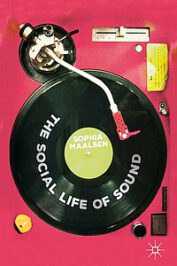Many publications of the last 30 or so years dealt with the social life (or interaction) of almost anything from objects, commodities to video games. Here comes one more title, it has the focus on the nature, social abilities and creative power of popular music. Or rather, it is on music that was re-discovered, re-arranged, re-sampled or at least inspired some previous musical output.
 Sophia Maalsen who lectures at the University of Sydney aims to identify certain relatively recent creative processes – like sampling, looping and remixing – that all share a common social connection with musics and artists who in that matter exist as quotes and at times are honored. Yet, as their original works are not always mentioned and more often than not legal fees for using copyrighted first works are avoided, such sampling often causes hostilities.
Sophia Maalsen who lectures at the University of Sydney aims to identify certain relatively recent creative processes – like sampling, looping and remixing – that all share a common social connection with musics and artists who in that matter exist as quotes and at times are honored. Yet, as their original works are not always mentioned and more often than not legal fees for using copyrighted first works are avoided, such sampling often causes hostilities.
Moreover, there is a huge number of musicians who would not call the mixing or looping engineer a very artistic person. Maalsen collected a number of interviews, statements and views on this from both ends of the creative industry, i.e. from the communities of vinyl collectors, musicians and composers, and then again, from DJs, producers (JB and Patrick Smith) and record labels.
“This book is about the social life of sound It is about archiving and curating music culture. It is about digging for records and making beats. It is about renewing the sounds and, frequently, the agency and personhood of artists who recorded those sounds years earlier. … It is about the tensions between the art of renewing sounds and the impacts of law, economics, (sub)culture, ethics, and technology upon the art.”
In eight chapters, she promotes her own definition of sounds, musical works and music in general that with such a concept in mind would finally end the common notion of artistic authorship “… as it is framed in Western systems of property” in favor of a copyright-free mentality, which would facilitate creative efforts.
Her approach in the first sections appears promising, as the social interactions of musical tunes of the past, in a way are still at work several decades after their original publication; just by being sampled and reissued by another person, as she describes it. And thus argues, that sounds or entire tracks can be traced back to one or more artists, and their re-sampling provides something similar to a new entry in its CV; using biographical methods, its social pedigree can be revealed. This is what she names the social life of the sound/track/sample.
As it turns, out, some readers may find that approach, that is strongly related to feminist studies, Bourdieu, and Foucault, not as fresh as her idea of analyzing music samples promised to be in the introduction. This in part can be attributed to strong similarities between of her theory and the writings of Daniel Miller (on material culture.)
Almost half of the book is devoted to case studies such as DJ samplings, loop extraction or the genesis of “new” tracks, which were strongly influenced by another person’s work.
Introducing a notion of “personhood” which would give certain “rights” to a sample or musical object, will not help matters, some would argue. The same goes for copyright property claims and variations of simple theft. (That history goes back centuries to countless composers of folk, blues and jazz music. In probably thousands of cases, for example, blues musicians were denied royalties and copyright for their creative output; authorship was changed to the producer or recording engineers).
Issuing copyright laws did, in fact, make sense, and most musicians will agree that abandoning these in favor of sampling artists or DJs unwilling to respect those, is not an option. To further develop a tune, some bars or a sample already in existence, is not to be compared to originate it. As much as one would have sympathy for a tune and a history and certain findings related to material culture studies, that may culminate in giving a sample a biography.
As hit tunes have been covered by other performers for at least one century by now, it is questionable if for example, a Boston street musician in 1939 would have insisted on being the partial copyright owner of a Tin Pan Alley tune he just performed and also heard another musician sing it some days earlier. With today’s technology, any contemporary practice would be little more, no matter how much “aura” and “personhood” value Maalsen would attribute to a loop and the like.
Her chapter on sampling in the research context is very good (although not revealing any new insights) and maybe fans of electronic music and some DJs may find this book gripping, as it boldly stands up for an idea of allowing a musical trace a certain identity and biography (and thus protection and dignity of a certain kind).
However, not all musicians, producers and sociologists may concur here.
Review by Dr. A. Ebert © 2020
Sophia Maalsen. The Social Life of Sound. Palgrave Macmillan, 2019, 267 p.
